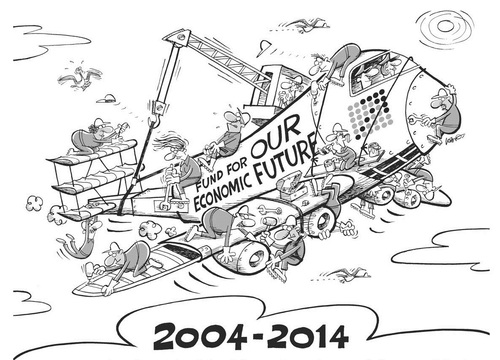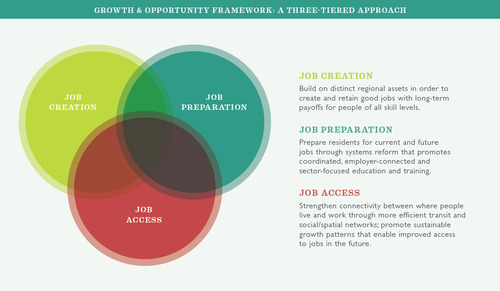Jun 25 2014 Growth & Opportunity: Elevating the Conversation on Economic Success
Guest post by Emily Garr Pacetti, Director of Research & Evaluation for Fund for Our Economic Future in Cleveland, Ohio.
 In the past few years that I’ve been at the Fund for our Economic Future (the Fund), I’ve heard the phrase “we’re building the plane while flying it” many times. True to a collective impact mentality that no one entity can create the large-scale impact that’s needed to turn around an entire economy; our cross-sector collaboration has a cockpit built for 50 and a membership that is used to getting their hands dirty. Our collaboration of philanthropic organizations spans four major metro areas (Cleveland, Akron, Youngstown and Canton) and represents about 4.4 million people across 16 politically and economically diverse urban, suburban, and rural counties. The Fund partners with private, civic, higher education, and public sector leaders on a range of issues that affect the long-term economic competitiveness of the region including entrepreneurship, innovation, and workforce development. From community foundations and faith-based foundations, to large corporate partners, community colleges, and universities, members understand that a healthy regional economy is critical to their own – often very distinct— missions.
In the past few years that I’ve been at the Fund for our Economic Future (the Fund), I’ve heard the phrase “we’re building the plane while flying it” many times. True to a collective impact mentality that no one entity can create the large-scale impact that’s needed to turn around an entire economy; our cross-sector collaboration has a cockpit built for 50 and a membership that is used to getting their hands dirty. Our collaboration of philanthropic organizations spans four major metro areas (Cleveland, Akron, Youngstown and Canton) and represents about 4.4 million people across 16 politically and economically diverse urban, suburban, and rural counties. The Fund partners with private, civic, higher education, and public sector leaders on a range of issues that affect the long-term economic competitiveness of the region including entrepreneurship, innovation, and workforce development. From community foundations and faith-based foundations, to large corporate partners, community colleges, and universities, members understand that a healthy regional economy is critical to their own – often very distinct— missions.
As you might imagine, viewpoints on how we achieve that mission vary greatly. The dynamic political, geographic, social, and economic environment around us makes consensus even more challenging.
Over the ten years that the Fund has been around, research has played an important role in getting everyone to align around common goals, and strategies to get us to our destination. In line with The Intersector Project’s Toolkit, we’ve built a common fact base, mobilized partners around a common agenda, executed strategies, and evaluated our successes and – oh yes – failures.
And the Research Says…
Time and time again, our research has told us that economic and racial inclusion is critical to the economic health of the economy. Traditionally, this has meant supporting work to increase minority owned businesses, payroll, and job creation. Last year’s analysis of 115 mid-sized metros in a post-recession economy reinforced this finding. Not only did more economically and racially diverse places fare better on jobs, productivity, and output measures; they saw incomes go up. Surprisingly, however, metros thatexperienced high job growth tended to see incomes decrease, and had higher levels of poverty and inequality.
The research challenged us to raise the bar on economic opportunity beyond “jobs.” Rather than focus simply on minority-owned firms, we propose a Growth & Opportunity framework that bridges the disconnect between the “growth camp” (economic development agencies, chambers of commerce) and “opportunity camp” (social service providers, non-profits, and foundations) at two levels:
Cross-Sector Collaboration (and I Don’t Just Mean Public-Private)
The G&O framework asserts that sustained growth can only come through cross-sector strategies that reinforce connections among employer demand (“job creation”), workforce and training efforts (“job preparation”), and the spatial and social disconnect between jobs and workers (“job access”). In short, a region’s competitiveness doesn’t just hinge on the number of minority owned firms, or integrated workforce systems, just as long-term competitiveness doesn’t just hinge on job creation. It’s a more complex equation, and certainly one that we are sorting out real-time with regional partners, from workforce investment boards, to chambers of commerce and economic development intermediaries to metropolitan planning organizations.

Local-Regional Collaboration
The health and wellbeing of neighborhoods and metro areas are interconnected. Metro poverty has a disproportionately negative impact on poor neighborhoods than on non-poor neighborhoods (see this recent brief by the Cleveland Fed), yet according to the 2012 study by ICIC, regional governance structures rarely addresses equity concerns in economically distressed areas. Suffice it to say that this is a growing field and – now armed with better and more localized data – we can be more deliberate in helping neighborhood strategies and regional strategies become more aligned and connected. A first step for the Fund, in partnership with the business community, is having one of four regional success measures be the extent to which we can “move the needle” on increasing labor force participation in economically distressed neighborhoods.
Like many civic leaders across the country, we are looking for ways to deploy our resources most strategically in order to prepare people for the jobs of today and tomorrow. In May, the Fund joined with partners from the Federal Reserve Banks of Philadelphia and the Federal Reserve Bank of Cleveland to introduce a Growth & Opportunity Initiative, announced at the Bridging Growth & Opportunity Conference in Philadelphia. The collaboration aims to connect and convene stakeholders across our respective regions on issues of job creation, job preparation and job access. Stick with us. More closely linking economic growth and access to opportunity in Northeast Ohio is a lofty but achievable imperative, and we know we’re not alone in the struggle.
For more information or to sign up for our monthly Growth & Opportunity updates, please contact Sara Lepro (slepro@thefundneo.org).
Emily Garr Pacetti is Director of Research & Evaluation for Fund for Our Economic Future in Cleveland, Ohio. Starting in July, she will be taking a leave of absence to pursue a Masters in Public Administration at Harvard Kennedy School of Government.
